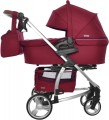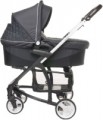Unit height adjustment
The ability
to adjust the height of the main unit (where the kid is placed) on the pushchair frame. Different location options have their own characteristics: for example, with a high installation, the kid will be closer to the parent, and with a low installation, stability increases and the pushchair will behave better on uneven roads.
Fastening in the direction/against the movement
In strollers with this function, the seat unit can be fixed in one of
two positions, to choose from: facing the parent (against the direction of movement) or facing away from the parent (in the direction of movement). Each option has its advantages: in the first case, the baby can see a familiar face and is less nervous, and when located in the direction of movement, it is more convenient for him/her to view the world around him/her.
Car seat installation
The possibility
of installing a child car seat on the chassis of the stroller. This feature can be very useful on car trips: the car seat can be used both in the car and as a seat unit for a stroller, and the main seat unit can be left at home so that it does not take up space in the boot. Note that some models with this function are initially equipped with a suitable car seat; if it is purchased separately, you should pay special attention to compatibility with your stroller.
Rear wheels diameter
The diameter of the rear wheels installed in the stroller.
The larger the wheel — the better it overcomes obstacles and bumps, the more convenient it is to drive the stroller over mud, snow and other difficult surfaces. For the rear wheels these moments are most relevant: for example, when driving the stroller over obstacles, it is usually tilted towards itself, so that the front wheels are in the air, and the rear wheels have to overcome the obstacle. On the other hand, small wheels weigh less and are easier to move, they are better suited for flat surfaces. So choose a stroller on this indicator should take into account the roads on which it has to be driven. If you plan to move on flat floors, good asphalt and stroller ramps — it is worth choosing small wheels, up to 20 cm. For difficult terrain, driving on mud and snow, regular overcoming steps and curbs it makes sense to pay attention to wheels in 30 cm and larger. And the diameter of 20 — 30 cm is an average option — it is suitable if you have to ride mainly on flat surfaces, but occasionally there is a need to overcome obstacles.
In box
—
Seat unit. A seat unit serves as the child's sitting area, suitable for use from 6 – 8 months onward when the child transitions from lying in a carrycot to sitting comfortably. All pushchair types feature seat units (see "Design"), except for classic and transformer models. Classic pushchairs inherently use a carrycot, while transformers use a unique device known as a "carrycot-transformer" (see below).
—
Carrycot. A traditional carrycot is a basket with high sides in which the child is lying down. Such baskets are intended for children in the first months of life - usually up to 8 months, no more; from an older age it makes sense to use a seat unit (see above). Carrycots are used in all types of pushchairs, except for pushchairs and transformers (see "Design") - the first type is completed only with seat units, the second uses the so-called " carrycot-transformers" (see below). A special kind of traditional carrycots are carrying carrycots (they are also described below).
—
Carrying carrycot. A variation of the carrycot (see above) designed to be easily carried separately from the pushchair. To do this, the design provides an appropriate handle. At the same time, not every carrycot that has a carrying handle (see above) belongs to this category of accessories: "carrying" are called only those carrycots that initially allow long-term carrying in the hands
...and have various design features that facilitate such transportation.
— Carrycot-transformer. In fact, it is a carrycot, which, if necessary, can be turned into a seat unit for a child who can sit up.
— Car seat. A specialized seat designed for the safe transportation of small children in cars is essential for compliance with safety regulations in many countries. Car seats are typically provided with pushchairs for babies up to 12 months and weighing up to 13 kg. However, a separate seat for older babies must be purchased. Before buying, it's important to check the specifications of the car seat, particularly the method of attaching it to the car.
— Foot cover. A cover designed to protect a child's legs in a pushchair from wind, cold and bad weather. While blankets or improvised solutions can be used for the same goal, complete covers offer more convenience as they securely attach to the pushchair and stay in place during movement. Additionally, if needed, a blanket can be placed inside the cover for extra warmth. It's worth noting that many pushchairs, lacking this accessory, allow for separate purchase. This accessory is primarily used with seat units, whereas carrycots rely on a leg-area canopy with a similar function, though it's not classified as a cover.
— Rain cover. A waterproof cover that protects the child in the pushchair from rain, snow and strong winds. Usually such a cover is made of transparent material or has transparent inserts — so that the baby can see the world around, and the parent can follow the baby. Rain covers for pushchairs are also sold separately, but if such an accessory is included in the kit, you do not have to worry about compatibility.
— Mosquito net. Mesh with small cells, which can cover a child sitting in a pushchair. The cells allow air to pass through, but trap mosquitoes, midges and other harmful insects, as well as small debris raised by the wind; such protection is especially useful during evening walks in the warm season, as well as when going out in the countryside.
— Bag / backpack for things. A separate bag that is usually hung on the handle of the pushchair. In such a bag you can keep various useful small things that need quick access: food, toys and hygiene items for the baby, parent's documents, etc. In most cases, the bag is removable, which provides additional convenience. Note that for some models, initially not equipped with a bag, such an accessory can be purchased separately. And some models are equipped with a backpack — a more convenient option for use.
— Shopping compartment. A device in the form of a basket or container installed at the bottom of the pushchair - under the cradle or seat unit. This compartment is convenient for storing purchases and other things that do not require quick access while walking. At the same time, larger and heavier items are placed in the basket/container than in a bag for things (see above); and the low position improves the stability of the pushchair. The shopping compartment can be either open or closed. The first option is found everywhere, the second - mainly in elite models (and such pushchairs can be supplied with two baskets: open and closed, or in different colors). The capacity of a closed compartment is often smaller, but the contents in it are securely hidden from prying prying eyes and protected from dust, dirt and moisture. Compartments for purchases are made from a wide variety of materials: plastic, metal mesh, fabric, etc. Soft materials are generally lighter, but less durable, hard ones are reliable, but can interfere when overcoming curbs and other obstacles.
— Cup holder. A stand on the parental handle to hold a glass or bottle with a drink - for example, milk for the baby or water for the parent.
— Hand strap. Strap on the handle of the pushchair, which the parent can put on his hand. This reduces the risk of dropping the pushchair: the strap is likely to keep it close to the parent, even if the arms are fully unclenched.
— Hand muff. An accessory that can come in handy when strolling in the cold season. The muff is attached to the handle of the pushchair; if desired, you can hide your hands in it so that they do not freeze in the cold. At the same time, the design of the muff is such that it does not interfere with fully holding the handle and driving the pushchair.
— Cover for pushchair. A protective cover designed for storing and transporting a pushchair during non-use hours is typically made from soft materials. It primarily protects the structure from dirt, direct sunlight, and moisture to some extent. While it offers symbolic protection against mechanical damage, more substantial safeguarding would require a case made of rigid materials. However, the need for such intensive protection is rare in practice. Soft covers are favored for their lightweight nature and minimal storage space when folded, making them the most popular choice for pushchairs. Overall, a complete cover tends to be more convenient, practical, and reliable compared to makeshift packaging.Chassis width
The distance between the side wheels of the pushchair; this generally corresponds to the overall width of the pushchair. If the front and rear widths are different, the greatest distance is indicated, usually on the rear wheels; the same wheels are used to measure the width of three-wheeled models.
In general, the wider the chassis, the more stable the pushchair is and the more difficult it is to tip it over. On the other hand, greater width can cause problems in tight spaces such as narrow hallways and doorways, elevators, etc. The narrowest modern pushchairs have a width
of up to 45 cm, the widest —
more than 70 cm (these are mainly models for twins or triplets , where two seats are side-by-side). Models
46 – 50 cm are also considered quite narrow, a width of
51 – 55 cm can be called small,
56 – 60 cm — medium,
61 – 65 cm — more than average,
65 – 70 cm — large.
Weight (complete)
The total weight of the assembled pushchair. For universal models (see "Design"), this paragraph usually indicates the weight with the seat unit installed: such an accessory is used for a longer time than the carrycot, therefore its characteristics are considered the most important. In addition, the difference in weight between cradles and walking blocks usually does not exceed 700 – 800 g (there are exceptions, but quite rarely).
Comparing similar models, a lighter pushchair may offer more convenience, but it often comes at the expense of reliability or a higher price compared to a relatively heavier counterpart. It's important to note that weight varies based on the pushchair type (refer to "Design"). Heavier pushchairs provide stability, reducing the risk of tipping over. The lightest models, weighing
less than 5 kg, refer to pushchairs and single-seat ones. Models in the
6 – 10 kg are also mostly pushchairs, including variations for twins. The
11 – 15 kg range is standard for universal pushchairs and transformers. Models weighing
16 – 20 kg are notably heavy, while those
exceeding 20 kg are rare and found among high-end double-seat pushchairs.

